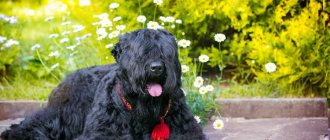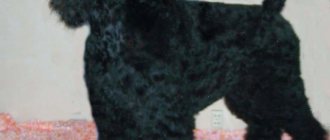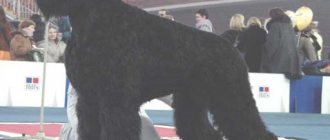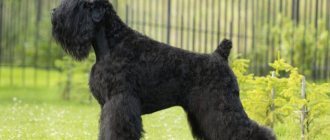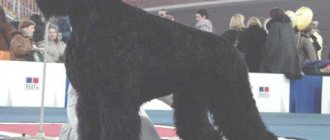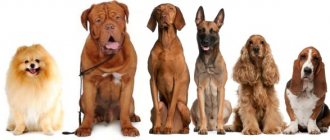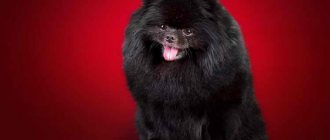Grooming is more than just cutting the dog's hair.
This is a set of procedures that, in addition to the actual haircut, also includes washing, drying, combing, trimming nails, trimming fur between the paw pads, and cleaning the ears.
This also includes stripping - combing out excess undercoat in wire-haired dogs. But trimming - pinching fur (dead hair) is not acceptable for the Black Terrier: The Black Russian Terrier is not trimmed!
Based on the type of coat, the Black Terrier is a wire-haired dog that requires regular brushing (combing down to the skin), trimming and washing. If this is not done, the wool will not be able to renew itself and will become tangled.
LiveInternetLiveInternet
Grooming and washing a black terrier. Let's understand the basic concepts: IN HUMAN LANGUAGE Grooming is a full cycle of actions for caring for an animal, depending on the owner's requirements, may include: cutting, washing, drying, combing, trimming nails, cleaning ears. Stripping is a procedure for processing the fur of black cats, combing out excess undercoat. Trimming is the plucking of fur (dead hair), which is usually performed 2-4 times a year, depending on the rate of its growth, and is carried out only on trimmed breeds. The Black Terrier is not trimmed. A groomer is a specialist in processing the hair of dogs, cats, and, at the client’s request, guinea pigs, rabbits, hamsters and other animals. There are many misconceptions about dog ownership that people use to justify their laziness. Here are the four most common: 1) you need to wash your dog as little as possible so that the coat does not deteriorate... 2) the blackie’s eyes and ears are weak points, so conjunctivitis and otitis are a given that you have to put up with, 3) stones from teeth can only be removed by a vet doctor, 4) we love our dog, but she doesn’t like all this hygiene. For each misconception, you can give a lot of refutations: 1. Try not to wash yourself or brush your teeth for three months, won’t people on the street shy away from you? Why is a dog worse? Both she and you (and the same passers-by) are pleased if the dog is clean and well-groomed, not to mention the image of the breed - it’s unlikely that anyone will want to buy a puppy after seeing a shaggy and dirty animal. And modern shampoos and conditioners not only do not spoil the hair and skin, but also nourish and strengthen. 2. If your blackie has problems with the eyes or ears, contact medical specialists (not general practitioners). Moreover, do not self-medicate, which can lead to the disease becoming chronic. 3. Dental hygiene is very important. If you do not monitor their condition, periodontal disease may begin, and the dog will simply lose its teeth. In addition, bacteria that multiply in the mouth (especially in the presence of stones) can cause diseases of the digestive tract. I am not a fan of brushing teeth with toothpaste - it has no effect and is difficult for the dog. It is much easier and more effective to remove stones that are just beginning to form mechanically once a month. This simple procedure is available to any owner. Of course, if you have neglected teeth, old hard stones can only be removed in a clinic and this is not cheap. 4. I understand love as caring, not blind love. After all, you force your children to maintain hygiene, brush their teeth and wash their hair - although many of them don’t like it either. Dogs, like children, get used to these procedures over time; perhaps they do not enjoy it, but they know that it is necessary and take it for granted. Your care for your pet will extend the years of his healthy, joyful life and bring pleasure to everyone who knows your four-legged friend! Bath day for a black terrier It is necessary to groom a dog for an exhibition 1-2 days before the start of the exhibition. The closer to the exhibition, the better the dog will look. Before grooming, the black terrier must be thoroughly combed and then washed. It is best to use show dog shampoo or shampoo with conditioner. Some dog owners believe that before a haircut it is not necessary to thoroughly wash and groom the dog, they say that after the haircut, we will wash it and groom it well for the show. I can disappoint you: the quality of an exhibition haircut directly depends on the quality of the wool prepared for this very haircut. Poorly washed or poorly groomed coat will not hold a haircut and all your and the groomer’s efforts will be in vain, and you will not be able to show your dog at the show in all its glory. Therefore, washing and drying the dog before grooming is the MOST important part of preparation, and this is 50% your dog's success at the show. The shampoo is diluted in water approximately 1 to 10 and whisked until foam forms. The wool is thoroughly soaked in this mixture down to the roots, and then washed off well with a stream of warm water. The ENTIRE dog needs to be washed, paying great attention to the head. All hair on the head should be thoroughly washed. Considering the characteristics of the black fur coat, it takes a sufficient amount of time to wet the entire fur coat. My 2 favorite brands are BIO-GROOM and #1 ALL SYSTEMS. You can read more about the use of a specific product on the manufacturers’ websites. We tried many different shampoos, but perhaps only 2 shampoos give the best effect on my dog’s coat - EXTRA BODY and WIRY COAT from BIO-GROOM and Crisp Coat Shampoo from #1 ALL SYSTEMS. Each of these shampoos has its own unique properties that the other does not have. For example: EXTRA BODY SHAMPOO (by BIO-GROOM) - this shampoo is popular among owners of long-haired dog breeds. It can also be used on animals with short hair to increase the optical volume of the fur. Also used in cases where you do not have the opportunity to wash the animal on the day of the exhibition. Tear-free shampoo that improves coat quality. Ideal for animals with thick undercoat. Gives volume. This protein-rich shampoo is formulated with pure beauty ingredients. Does not dry out or injure the coat. Has neutral Ph - control. It is washed off easily and without residue, leaving the wool of the desired quality. You can dilute 1 part shampoo to 4-5 parts water. WIRY COAT SHAMPOO (by BIO-GROOM) - “Tearless” shampoo for wire-haired dog breeds. Concentration 1:4. Suitable for wire-haired breeds of animals. Emphasizes and improves hair structure. But we know of kennel owners who use it for animals with long, excessively soft hair and consider it ideal for some of their pets. Shampoo “no tears” for wire-haired dog breeds. Adds the desired perfection to coarse hair, improves structure, rinses well, deodorizes and adds volume without damaging the hair. Improves the color of any color, making it deeper. Easily washed off. Ph - neutral CRISP COAT SHAMPOO (company #1 ALL SYSTEMS) - This shampoo is rich in texture-enriching and dirt-removing plant extracts. Helps remove chlorine and harmful contaminants. Purified plant fragrances refresh the coat. Shampoo made from 100% plant based cleansers
I apply shampoo to the dog’s fur 2 times, the first time the main dust is washed off, and the second time the washing itself takes place. After you have washed the blackie with shampoo and rinsed the coat thoroughly, it is advisable to use a conditioner-balm. There are a great variety of them, and you can choose. In order to make the right choice of conditioner, as well as understand the meaning of care, you need to remember: the coat of a black cat needs volume and no weighting! You need to proceed from this rule when choosing care products, and accordingly, cosmetics containing oils are not suitable. I found a conditioner for myself from #1 ALL SYSTEMS - SUPER RICH PROTEIN LOTION CONDITIONER (from #1 ALL SYSTEMS) . This air conditioner is an achievement of the latest developments from #1 All Systems. Carrot and grape seed extracts included in this product allow you to instantly condition the wool, giving it the necessary texture and shine.
Cares for the fur very carefully and protects it from the static effect for a long time. Makes it smoother and silkier. Controls most wool problems, significantly reduces tangling, and gives the coat a finished show look. The conditioner is diluted in water 1:10 and rubbed well into the wool. We wait 5-6 minutes. Then we rinse the wool with running water, but not too much; some of the conditioner should remain on the wool. There is no need to rinse off the conditioner completely. I noticed that manufacturing companies have a much larger selection of hair care products, which require oils and weight. There are very few products that add volume, moisturize and are light in texture. We are still looking for the perfect conditioner, and haven't liked any of them 100% yet. The French conditioner from HERY is quite good - it really doesn’t weigh it down and adds volume, as it says on the label, but this product is not concentrated. In order to get the desired effect, you need to apply it in a very thick layer, and as a result, the entire bottle was used on an adult male dog before the show. So, the blackie is washed, wrung out and ready to leave the bathroom. You need to stock up on a large number of towels and a powerful hair dryer (in winter this is simply necessary), because drying the blackie is very difficult, and ideally it is advisable to purchase a professional hair dryer, which, due to the powerful air flow, literally knocks moisture out of the undercoat and greatly reduces the drying time. Such hair dryers are quite expensive in our country. I dry my blackie's coat by constantly brushing him against the grain. It takes about 2-3 hours if you use a regular hair dryer with a power of approximately 1800 watts and 40 minutes if you use a professional hair dryer. By correctly using the air flow, you can achieve a large volume of hair on the entire dog. Blow dry your dog until it is completely dry. You can use an antistatic agent, there are a great many options for using it and you can get different effects each time. The method of its use is individual for each dog. It is very convenient to dry your dog on the grooming table. If the dog does not have enough hair volume (genetically or during the molting period), special foams can be used before the show. #1 ALL SYSTEMS has three types of color balms for different coat colors. I don't use them, but if your dog's fur is faded in the summer, they can be a lifesaver before a show. It is necessary to protect the wool with special products with UV protection. This may not be relevant for domestic dogs, but for kennel dogs or dogs that spend the entire summer outdoors in the countryside, this may be useful. And only when the dog is completely dry can you start cutting.
Black Russian Terrier Grooming
Trimming the hind legs - Starting from the hock joint, 1-2 cm above it, with an electric clipper (leaving 5-6 mm of hair), clip the back of the thigh to the anus. On the thigh, the fur is left 8-10 cm with a smooth transition from longer (edge of the thigh) to shorter fur. With a properly trimmed thigh, structural defects and weakness of the hind limbs can be hidden to a greater extent. I would like to emphasize once again that after a haircut, a black terrier should have beautiful, natural silhouette lines with smooth transitions from long to shorter hair. His appearance should exude confidence and strength and in no case give the impression of being overly decorative. Figure No. 1 Shown in blue - We cut the back of the thigh with a machine. 2 cm above the hock and up to the anus. The red arrows show that the scissors are parallel to the thigh and we remove all the protruding hairs from the inside of the thigh. The yellow line shows - using scissors from bottom to top, we cut in a straight line the inner side of the thigh (but both legs). From behind, your legs should appear straight.
Figure No. 2 Shown in red - we make a line for the back of the thigh. We compare the long hair on the thigh (8-10cm) with the short shaved electric clipper (blue color in picture No. 1.) We comb the hair as shown by the arrows and then use scissors from the bottom up to make a beautiful curved line of the hind legs. As in the picture. It is shown in blue - we comb the hair back and cut the hind metatarsus at an angle. Yellow shows how to trim the fur on the front of the thigh.
The tail is cut evenly along its entire length. The length of the hair on the tail is 5-6 cm. The tail should be in harmony with the body. The tail should look thick and powerful from all sides. The tail determines the dog's bones. If the tail is thick, then the dog has a strong backbone. Therefore, you should not cut your tail short. If the tail is docked too short at the end, you can leave longer hair, which visually slightly increases the length of the tail.
Back and side haircut. We cut the back with scissors: from the tail towards the withers, we comb the hair up and forward and cut with scissors from the tail to the withers (Figure No. 3, the back line is highlighted with a brown line). On the croup and near the base of the tail, 2-3 cm of hair is left, then gradually towards the withers the length of the hair increases, and 7-10 cm long of hair is left on the withers. This is done in order to emphasize the well-developed withers of the dog. And a pronounced high-forwardness. The croup should flow smoothly into the tail. The tail should not extend above the line of the back or be below the line of the back. Figure No. 3 is shown with arrows, a transition is made and the coat is compared from short hair on the back to longer hair on the sides.
Figure No. 4 The back line is shown in blue. The withers stand out. The dog is made high-fronted. The sides are cut evenly and smoothly. The sides should be rounded (shown by red arrows). The length of the fur on the sides is 8-10 cm. The fur on the sides is combed up and cut from the bottom up. Yellow lines (shading) - here it is necessary to make a smooth transition from shorter hair on the back to longer hair on the sides. The transition should be smooth, and the lines should flow smoothly into one another.
Drawing No. 5 The skirt line is cut in a straight line. (yellow color) Dogs with well-developed chests should not be left with a “skirt” that is too long. The strict line of the chest, which drops slightly below the elbow and turns into a moderately tucked belly, gives a particularly impressive appearance to a well-developed dog. In addition, the long “skirt” left on the already well-developed chest gives the front part of the body excessive heaviness and squatness.
Trimming the neck and chest - from the base of the auricle, draw a line to the junction of the lower jaw and neck, starting from the base of the auricle and down to the sternum (keel) and down 3-4 cm, cut everything short, with an electric clipper or scissors (leaving the hair 5-6 mm) so that you get a so-called “shirt front”. Figure No. 6 The blue color shows the line along which you need to cut the “shirt front”. The structure of the shoulder (scapula) and sternum (keel) is shown in yellow. Feel for this shoulder structure (bone) in your dog. The shirtfront neck is cut further (more than) these bone protrusions. This will make the dog's neck look longer and more stylish. Then we cut the scruff (upper part of the neck). Carefully combing the hair against the hair growth, cutting off all excess with scissors from top to bottom, form a mane (the length of the hair on the upper part of the neck (5-7 cm). Try to make the transition from the scruff to the withers as smooth as possible, otherwise, you may end up with a short-cropped neck protruding from the body covered with long hair. On the side of the neck, the transition from long hair to very short hair is made smooth. The length of the hair on the mane should correspond to the characteristics of the dog. On a thin and long neck, the hair is left longer, and on a thick one , short - shorter.
Figure No. 8 From the front, the “shirt front” looks like this (shown in blue). The yellow dot is the keel (sternum), the yellow lines are the shoulder bones. The shirt front is cut just below these bones.
Figure No. 7 The arrows show - we comb the wool up and make a smooth transition from the length of the wool on the sides of 8-10 cm to the short one on the “shirtfront”
Chest (shoulder) haircut
Figure No. 9 The breed standard states: “...The front part of the chest of the black terrier protrudes slightly in front of the line of the shoulder joints...”. I think it would be very nice to emphasize this point. It's done like this. The blue lines show the boundary between the short coat on the lower part of the neck and the longer coat on the shoulders. It is not advisable to make this boundary sharp. All lines of the black terrier's haircut smoothly transition from one shape to another. All parts of the body must be proportionate to each other. Starting from the beginning of the long hair down from the chest bone, 4-6 cm long hair is left. The front part of the chest is formed with scissors. A beautifully cut front with an accentuated shoulder line creates the impression of forward movement.
There may be options here:
Drawing No. 10 The shoulder line should be round. And end approximately at elbow level. The blue dot on the front paw shows where the chest line ends. And the red dot shows where the elbow is.
The second option is possible when the rounded part of the chest (blue dot) ends just below the elbow line (red dot).
Figure 10.1
Grooming of the forelimbs - the forelimbs should be carefully combed with a comb against the grain upwards and with scissors, remove all excess, and form “columns”. The tangles are combed out, and the thick tufts of hair between the pads of the toes on the paw are cut off, because They are often the cause of an insufficiently collected paw. Then trim any protruding hair so that the paw appears round. The claws should stick out a little. Haircut of the head Figure No. 11 Comb the fur on the dog’s head and face in the direction of hair growth, freeing it from previously uncombed tangles and dead hair. Cut your ears short inside and out. But it is best to trim the ears after the entire haircut is completed, because... prickly small hairs that get into the ear canal cause discomfort in the dog, causing it to constantly shake its ears, which is very tiring for the hairdresser. The easiest way to trim the ears is with an electric or mechanical clipper, but you can also use scissors, from the tip of the ear to its base, but at the base of the ear the hair is left as long as on the head and a smooth transition is made from very short hair on the ear to longer hair at the base of the ear , this is done so that the ears do not appear too tight to the cheekbones. Hair that hangs down at the edges and makes the ears appear larger must be carefully trimmed with scissors, trying not to damage the ear. On the forehead, starting from the brow ridges, cut short, using a machine, an area equal in width to the width of the skull, and in length – to the base of the ear. The remaining part of the forehead is cut with scissors so that there is a smooth transition from short cropped hair to longer hair at the end of the skull. This is done in order to be able to form a so-called “cap”, which is cut behind the occipital protuberance and creates the impression of a longer head.
The fur on the cheekbones is almost not cut, but only the ends of the fur are trimmed. There should be a lot of hair on the cheekbones so that the head looks very massive and wide.
And then the head is given a “brick” shape (when viewed from above), smoothing the transition from short hair to long hair, forming a mustache and beard. When viewed from above, the head should have the shape of a rectangle, and when viewed from the side, a triangle, where the bangs, mustache, and beard form a right angle. The line of the bangs should be a natural continuation of the forehead, emphasizing its straightness and parallelism to the back of the nose. A bang formed too low or too high distorts the parallelism of the forehead line and the back of the nose and changes the proportions. All hair protruding beyond the rectangular outline of the head must be carefully cut off. Then, thoroughly comb your entire head and trim any stray hairs. Now all that remains is to form the beard and mustache, giving them the shape of a triangle when viewed from the side.
11.1. Correct head structure. The fur on the cheekbones is trimmed a little, the head is given a rectangular shape.. 11.2. The head is too narrow in the skull. On the cheekbones the fur is left at maximum length. 11.3. The head is too wide in the skull, leaving a minimal amount of hair on the cheekbones.
11.4. Correctly formed bangs. The length of the skull and muzzle is the same. 11.5. The bangs are too high. The length of the skull seems very short and the length of the muzzle is too long. 11.6. The bangs are too low. The length of the muzzle seems too short.
11.7. Use scissors to remove all protruding hairs and form a rectangular head. 11.8. Correctly formed head. 11.9. The head at the transitions is not processed, the mustache is too bushy. 11.10. Lightened head. In the Kerry Blue Terrier type.
KIND OF READY DOG
Taken from: https://d-keitos.narod.ru/QUESTIONS/195.htm
There are three types of hair in wool:
guard (integumentary);
downy (undercoat);
sensitive (vibrissae).
Guard hair usually dominates the length of a dog's coat, creating the overall impression of hair. Its function is to protect the body from abrasions (in the armpits and groin - from friction) and to prevent the underfur from being crushed.
The undercoat, consisting of numerous downy hairs around the guard hairs, is the dog's main insulator. Downy hair is the thinnest, most delicate, with numerous curls.
Sensitive hairs are the fewest. They are located on dogs' lips, chin and eyebrows. They perform a tactile function and, apparently, a function similar to taste. The vibrissa root is supplied with a significant number of nerves and blood vessels. Sensitive hair is normally longer than the surrounding hair, it is hard and almost straight. The influence of this hair on the exterior is small; it is clearly visible only in short-haired dogs.
Head.
- Head - front view
Approximate boundaries of head shaving.
- Smooth transition from shaved to long
- Determining the boundary of the area on the head
The ear is shaved with 2-5 mm knives according to hair growth. If the knives of the machine are longer, you can do it against the height.
The area on the forehead is shaved or cut very short with scissors. Starts from the brow ridges to the front edge of the ear, slightly narrower than the width of the skull. If the dog has noticeable bones on its skull, it is better to straighten it with scissors so that it is not noticeable. Transitions from short to long hair should be smoothed out. The cap over the ear is designed so that the ear is small and has a triangular shape. The length of the hair on the cap is a matter of taste and anatomical features of the dog. If the head is short and narrow, it is better to leave the hair on the cap quite long. But hair that is too long will fall and “lick” a narrow (/short) head, so everything should be in moderation. From above, due to the decorated cap, bangs, beard and sideburns, the head should have a rectangular shape.
Sideburns (Long hair on the temples, cheekbones). If the neck is narrow, then it is better to leave the sideburns long. Very long hair will visually cut off a short neck even more. But remember that there is an upper neck line.
To shave or not to shave the bridge of the nose is a matter of taste. If you shave, you will have to constantly trim the hair under your eyes. And the opinion that a shaved bridge of the nose makes the muzzle visually wider is very controversial; it depends on how the hair grows, on the width of the muzzle and the bridge of the nose (even with a wide muzzle, but a narrow bridge of the nose and clingy hair, the effect will not be very good)
How often do you need to wash and cut your Black Terrier (meaning grooming - a full complex)?
This largely depends on the living conditions (apartment, enclosure), time of year (season), type of coat, and age of your pet. On average – once every one and a half to two months.
Trust our experience: even if we do not consider “severe” cases, a dog after a haircut not only looks “cool”, it behaves and feels differently. Nothing bothers her, she blossoms, she flies...
In addition, before the haircut, our experienced professional breed groomer will definitely evaluate your dog’s exterior, perhaps even with more reliability and passion (in a good way) than experts do in modern show rings. After all, the groomer, unlike experts, is not in a hurry; he will communicate with your dog for at least several hours, or even all day. And his task is to, based on this assessment, hide the shortcomings with a haircut and emphasize the advantages of your dog.
If he notices health problems in your dog, he will definitely not only tell you about it, but also suggest possible options for eliminating these problems. Yes, yes, don’t be surprised, he is not just a groomer, he, as they used to say, is a dog breeder in the best sense of the word!
And when the owner takes his dog after a haircut with the words “Oh, what did you do to my dog?” "What is wrong?" "No!!! Amazing!!!” – the groomer is not only happy, he is proud of the breed: another dog has joined the ranks of the magnificent Russian Black Terriers!
Errors.
- Forbrust size 5+ and low hemline.
- The head is cut like Risen's. The groin is overly emphasized. For tall-legged dogs, do not raise the chest-leg transition point.
And finally, some tips.
If you still decide that you can handle the grooming (I emphasize once again - a full range of procedures) of your Black Terrier yourself, then you should stock up on a lot of patience and several professional
tools. Among them:
- scissors for haircuts. Keep in mind that even very good tailor's scissors are not suitable for “black hair” - they will not cut the hair, but chew it, destroying the structure of the wool;
- scissors for trimming fur between the paw pads. The quality requirements are the same, but in addition they must be small and have rounded ends;
- combs. All combs must be made of stainless steel with teeth rounded at the ends, i.e. so as not to scratch or irritate the dog's skin. At worst, combs with good anodizing quality are suitable. Combs should have a tooth length of 4-5 cm and there should be at least two of them: with a tooth pitch of about 1 cm - for “rough” combing and with a tooth pitch of 2-3 mm - for “finishing” combing. As the first comb, you can use a single- or double-row “rake” with the same length and tooth pitch. The second comb is designed not only to completely comb the entire dog again after the first comb (“rake”), but also to check the quality of work: a fine-toothed comb should freely pass along the entire length of the coat from the roots (from the skin) to the ends of the hair throughout the dog’s body;
- slicker brush with long teeth. The quality requirements are the same as for combs;
- wool clipper. Very desirable;
- a nail clipper is a must (you can read an informative short article about trimming claws here);
- stripping – I don’t recommend it
: without skill you will “kill” your dog’s fur; - Shampoos, conditioners, conditioners are a must! This is not a luxury, but a necessity. As a rule, “human” cosmetics are not suitable for Blackie. I will not give advice on what kind of cosmetics and what brand you should use. And that's why. Not only is there a great variety of these cosmetics in our time, but you also need to see your dog. It won’t be simplified: as described above, there are three main types of wool, therefore, there should be three types of cosmetics - for each type - its own. If only it were that simple! I recommend - contact your Breeder, show him your dog in its current state and he will tell you exactly what cosmetics your pet needs at this stage of his life;
- a hair dryer - and not just a good hair dryer, but one that allows you to dry with a powerful stream of cool or warm air, but in no case hot;
- sheets, cotton and terry - preferably a little shabby, they will better absorb moisture when you wrap a “freshly bathed” blackie in them;
- a table for a haircut - a groomer's table - is very desirable, otherwise you will have to spend the entire time of the haircut squatting, on your knees and in a half-bent position. And this will one way or another affect the quality of the haircut.
Finally, the area or room in which you will be grooming your dog should be very well lit. The lamps should not emit a lot of heat: you and the dog will be hot anyway.
Rinse your dog well.
- If the dog has not been washed for a long time, use a super-cleansing shampoo, special for dogs or purchased in a regular store, for the first wash.
- Next, if the dog is going to a show, use a special texturizing shampoo. For coarse coat, for volume, what is needed specifically for your dog, now there is a large choice, you can use #1 ALL SYSTEMS Crisp Coat or Laser Lites Ti-Tree & Citron Shampoo, Beekeeper Professional Energy of Natural. It is better to choose a shampoo long before the exhibition, since its effect will depend not only on the dog’s hair, but also on the water in your region.
- Rinse the dog until the rinsed water is clean and the dog’s hair squeaks all over the body (and don’t forget to check the paws)
- Balm after washing - any necessary for the coat. A moisturizing balm is often used for black cats; it is especially good for decorating the paws. If your dog is preparing for a show, you should not use balm after texturizing shampoo.
- Comb the dog all over the body again.
- It is better to dry it under a powerful hairdryer, with or without a comb, slicker brush (korchetka), depending on the type of dog’s coat. If your dog’s hair becomes very curly after drying, then it is best to use a slicker while drying it under a hairdryer. A very powerful hair dryer (compressor) will knock out the remaining dead hair, making your work much easier and reducing drying time.
So, the quality of the haircut will depend on how well you wash and dry the dog.
Is the dog completely dry? Checked for tangles with a wide-tooth comb? If so, give your dog and yourself a rest period of at least 2 hours. During this time, the fur will settle down a little, perfect for cutting.
The Black Terrier is a hypoallergenic dog breed.
Its presence in a house or apartment does not cause allergies even among “capricious” and allergy-prone people. But a haircut is a special case. You will need a gown, gloves and a respirator. The short, fine hair of the Black Terrier will “hang” in the air and dig into your body; inhaling this “wool-air” suspension is strictly prohibited! In my opinion, the profession of a groomer should be considered particularly harmful.
And one more important detail. The dog is not a stone sphinx. Most likely, especially for the first time, it will seem to you that she is too nervous: in the bathroom she will shift from paw to paw, try to sit down when she should be standing, shake herself off, spraying you with a soapy shower, and try to jump out of the bathtub. While drying and combing, it will show signs of anxiety, “take away” your paws, turn away its head, etc. Maybe you will even hear a guttural roar and be surprised: MY dog is growling at ME?
Are you tired, your hands can’t hold a comb, your back feels stiff? You are not alone - the dog is also tired, she also wants to take a break from these procedures. My advice to you is to take breaks, give yourself and the dog a chance to rest a little.
The grooming standard for the Black Terrier is briefly described on the website of the RCHT NCP.
I’ll tell you from myself. I have seen “a thousand” times how our groomer bathes, dries, and cuts Black Terriers. Ours and others. I bathe and brush the dogs myself. I am writing these recommendations for you because theoretically they are correct and theoretically I know exactly how this is all done. But I will never undertake the practical application of my theoretical knowledge in grooming the Black Terrier. And not because my hands are “crooked”. No, they are even for me. But because I clearly understand: in any business, and especially in this, you need not only experience and skill, but skill and talent too!
Of course, groomers are not born, but...
So good luck to you!
And consider the following.
Frame.
- Approximate boundaries of where the neck is shaved. Keel and blade.
- The fur on the chest in front is smoothly cut to the elbow line (fold) or slightly below
- The hemline on the side of the chest should be just below the elbow
- If there is not enough behind the tail and/or the rear angles are modest and/or the body is over-squared
- Roundness transition points front and back
- Line of croup - ischial - thigh.
- The angles of the hind legs can be adjusted by the length of the hair on the back of the shin.
- Possible design of the inguinal fold.
- Approximate boundaries for stripping work.
- Neck design - shirtfronts
……….
- Option with shaving going to the inner thigh
- Transition back (croup) - hip
- The fur on the paws is cut so that they are parallel
- If the dog's chest is higher than the elbow, leave the fur longer
The lower part of the neck, the “shirt front”. Shave from the base of the ear down to the shoulder blade. The skin on the neck can be pulled up a little and shaved down until it touches the shoulder blade. The lower part of the neck is shaved from the jaw to the keel. The skin is also stretched, shave down until it reaches the keel. The side of the shirtfront is quite often lowered below the upper edge of the shoulder blade. They say that the neck appears longer. But for dogs that are not wide enough, this should not be done, since this defect will be emphasized. The border between shaved and long hair must be straightened with scissors (thinning).
Front, forebreast. From the keel to the bend of the leg at the elbow (higher if the dog is squat, lower if the dog is tall), the hair is cut smoothly.
The underline (chest - belly) should be below the elbow, smoothly rise up to the hip, forming a deep chest and a moderately tucked belly (groin). If the dog is very stretched or has a very narrow hip, or... the inguinal fold can be decorated with a “curtain”, thereby extending the hip line and shortening the bottom line. But the wool there is usually sparse, and therefore does not look great.
Line of croup - ischial - thigh. With this line you can visually correct the slope and length of the croup, the width of the hip, the set of the tail, the angles of the hindquarters and even the format of the dog. You should not bustle the dog, especially if there is no need to correct the above anatomical features.
Tail. The fur can be left equally short along the entire length. But a feathered tail will look better if it is curled or J-shaped. A docked tail is cut the same length all the way through, but if the tail is curled, vary the length of the coat to visually correct it. If the tail is very short, leave more hair at the tip.
Hind legs. The hair from the anus is shaved downwards. Often the lateral borders of the shaved area are drawn along the ischial tuberosities. If the dog's rear is wide and powerful, then it can be opened more. Whether to shave the inner thighs is up to you, but if the dog has a narrow thigh, it’s not worth it. . If the thigh is well muscled, highlighting the shaved thigh will add a nice volume effect. The lower limit of the shaved is also a matter of taste. If you shave according to option 3, then with scissors you cut it quite short to the bend of the thigh - lower leg, the rest - according to the anatomical features. If, for example, it is necessary to “increase” the thigh-shin angle, then the coat can be left longer, but leave the transitions smooth.
The bitch's loop is shaved. The scrotum of male dogs is trimmed/shaved short, or you can leave a covering “curtain” over it.
Peculiarities of haircut of the Black Russian Terrier
A fairly large number of breeds were involved in the process of breeding RCT. The result was a dog with black, coarse and very thick hair. However, not all individuals have identical coats. Some blackies may have one where there is more topcoat hair, while the undercoat is weakly expressed. It also happens that both layers are balanced. And sometimes you can find terriers whose guard hair is almost suppressed by the undercoat.
So, the first option is considered the easiest to care for, when the hair is long and the undercoat is not too pronounced. No tangles form on such wool, and dirt does not stick to it. However, as the guard hair grows, it becomes thinner. To prevent the dog’s appearance from deteriorating due to this, the hair needs to be shaved along the body and on the hips along with the undercoat. The optimal frequency is once a year.
@ladislavalandova
To maintain an acceptable appearance, dogs belonging to the second group require regular brushing. This way the wool will be able to retain its texture much longer.
Dogs with a dominant undercoat require much more grooming than others. Their fur needs to be brushed every day. Usually their “fur coat” looks matte and even dull.
Important! The beard, bangs and mustache, which are much tougher, need to be washed and combed.
